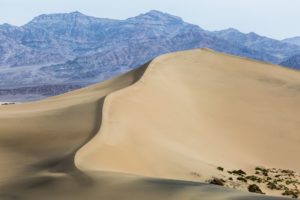Running out of water in any place, whether it’s the lush forests or the rocky mountains, is always not a good sign of things to come, especially if you still have a-ways to go before you can finish the trail.
Doubly so if you run out of it in the middle of the desert. The scorching heat coupled with your intense sweating means that you are losing a lot of water fast, probably double or even triple that of a usual hike. A mere hour or so can leave you completely dehydrated, and if you don’t manage to get water at that point, you may end up down for the count.
This is why water is always emphasized as an essential during a trip through the desert. Thanks to the nature of the environment, water itself is a scarce resource (deserts on average only receive around 10 inches of rainfall per year), meaning that most of the water around the area is likely from the water bottles and jugs that you brought along. Overshooting and having way too much to drink and bring is much better than the alternative of finding yourself parched in a dry land with no help coming for hours.
But let’s say an accident happened. Maybe you made a mistake and accidentally spilled all your remaining water, or you were not able to pack enough of it for the trip. Instead of wasting time lamenting the loss of your water, check if you have not made it too far away from your starting point. You might still be able to get back with whatever water you might have left.
Failing that, however, you will need to use your wits to survive and find water, no matter where, at least until you can get back to safety, so where can you find water in such a barren land like a desert?
Search for broad-leafed trees
Trees like willow, aspen, cottonwood, and palm are sure signs of the existence of a water source nearby.
They are quite easy to spot, owing to their colors standing out from the usual desert hue, meaning that if you find one or more thriving in a certain spot, there is likely water nearby, likely in the form of a spring, or near a waterhole.
If there is no water source that you can see, you can dig a hole towards their roots and get the water from it to hopefully quench your thirst and fill up your water bottles.
Broaden your search on higher ground
Even though palm trees stand out in the desert, being on even territory does not help you see too far, which can be troublesome if you want to conserve your energy as much as possible while searching for water.
Going on higher ground will give you a boost in vision, especially if you have binoculars. You will be able to scout the area and see if you might miss running into a water source, or if your surroundings are just a waste of time and that you should keep pressing forward. Keep the heat of the sun in mind when you head on a higher vantage point though, you probably won’t have a lot of cover up there, if at all.
Follow birds and insects
Animals are living and breathing creatures as well. That means that, just like you, they need to survive by getting energy from food and water. Food will not necessarily become a problem immediately, so you can ignore that for now and focus more on water.
While some animals have adapted to surviving without water for extended periods of time, certain ones, like birds and bees, appear when there is a water source nearby. Bees do not stray too far from their hives, and they need to be not too far away from a water source to survive in such a harsh environment.
If while hiking, you suddenly encounter a buzzing friend, keep an eye out. You may just find something to drink.
Check inside north-facing canyons
North-facing canyons can fill up with snow or rainfall. However, unlike most of the desert, these places usually do not have too much southern exposure and sunlight exposure during the day, which means that the water does not evaporate away.
As a result, they can pretty much act like water basins for months on end! Do keep in mind that it is still exposed to the elements, and thus might be stagnant and murky. If you have a water filter with you, now’s the time to be using it.
Eat cactus fruit, but don’t drink from the cactus itself
Cactus fruit such as prickly pears help boost your system, but don’t count on them to keep you alive for the entire trip by only eating them. You need much more water to survive the desert, and while it is important to still eat these fruits to help you survive, they should be seen as a band-aid solution while you find a better water source.
If you are thinking of drinking from the cactus itself, don’t bother. Movies and cartoons lied to you; a cactus does not have water. Instead, it has a liquid filled with alkali that will give you stomach problems more than help you feel better. Your body can still ingest them, but it might be worth questioning whether it is worth the trouble that your body will feel.

